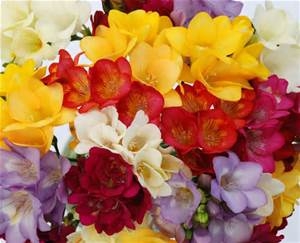
Freesias are a member of the Iridaceae family. They were first found in Cape Province, South Africa, about 200 years ago by a German physician named Friedrich Heinrich Theodor Freese. Most of the varieties that thrive in California descend from just two of the many hybrids Dr. Freese discovered.
Freesia blooms grow along one side on a slightly branched stem with tuft-like narrow leaves. Most varieties reach about one foot in height.
Many flowers have ancient myths attached to them, but freesias, being of recent discovery, leave no tales in their wake. In modern florist language, freesias symbolize innocence and friendship and are the commemorative flower for the seventh wedding anniversary.
Like other plants indigenous to Mediterranean climates, freesias do best where winters are wet and summers are dry. Many favorite plants in Napa County gardens—perhaps some you grow—originated in southern Africa.
Freesias look best planted in groups or masses rather than in tidy little rows. They bloom pretty dependably 10 to 12 weeks after planting, so with careful planning, you can have blossoms in beds and pots throughout dreary winters and rainy springs. Read the labels at the nursery, however, because some propagators pre-force corms to provide blooms as early as five to eight weeks after planting.
While gardeners in most areas wait until March to plant freesias, Napa County has warm-enough winters to give us a jump on these colorful, fragrant blooms. You will see freesia corms in local nurseries this month.
Freesia corms are fragile, and the fresher, the better. Know where you intend to plant them before you head to the nursery to pick them out. For the most robust blooms, get them in the ground or into pots as soon as you can.
To plant in beds, prepare the soil about a foot deep. Make sure the bed drains well since standing water will rot the corms. Freesias prefer full sun or light morning shade but have done well almost everywhere I have planted them. Plant the corms two to four inches apart and two inches deep, then water the bed well.
Freesias also thrive in pots. Just fill the pots with good potting soil and plant the corms about an inch deep with their pointed ends up. Keep the soil moist but not soaking wet. Six corms will fit comfortably in a five-inch pot. Be sure to plant them where you can enjoy the sight of their arching, trumpet-shaped flowers and catch their wonderful scent.
Once foliage emerges, keep the beds or pots moist. Do not let the soil dry out until the flowers have faded and the foliage begins to yellow. You can deadhead the blossoms so your garden looks neat, but leave the foliage to die back naturally. The leaves provide the energy for the corms to store for next season's blooms. If your freesias are in pots, you can move them to a resting spot, out of sight, until they are ready to bloom again.
You can experience freesias indoors in two ways. You can force bulbs in dishes or pots, or you can enjoy the blooms as cut flowers in vases.
To grow freesias indoors, plant fresh corms an inch deep, pointed end up, in regular potting soil. Water well and find a sunny, south-facing window to perch them in. Expect your bouquet in 10 to 12 weeks.
When the show is done, let the pots dry out and start over. A favorite ceramic pot full of freesias is beautiful on a desk, on a kitchen windowsill, or in a sunny bathroom.
Long-lasting freesias are a lovely choice when you are ordering a bouquet from a florist for friends or family. With a change of water daily and a little floral preservative, freesias can look fresh and smell divine for up to three weeks.
Workshop: The UC Master Gardeners of Napa County will host a free workshop on “Worm Composting” on Saturday, September 26, from 9 a.m. to 11 a.m., at the Napa Valley Museum, 55 Presidents Circle, Yountville. Explore worm composting, an ideal solution for composting kitchen scraps and returning the nutrients to your soil, especially when outdoor space is limited. Co-sponsored by Napa Recycles! Free Online Registration.
Master Gardeners are volunteers who help the University of California reach the gardening public with home gardening information. U. C. Master Gardeners of Napa County ( http://ucanr.org/ucmgnapa/) are available to answer gardening questions in person or by phone, Monday, Wednesday and Friday, 9 a.m. to Noon, at the U. C. Cooperative Extension office, 1710 Soscol Avenue, Suite 4, Napa, 707-253-4143, or from outside City of Napa toll-free at 877-279-3065. Or e-mail your garden questions by following the guidelines on our web site. Click on Napa, then on Have Garden Questions? Find us on Facebook under UC Master Gardeners of Napa County.